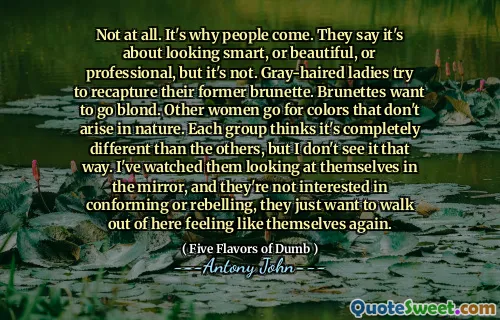
Not at all. It's why people come. They say it's about looking smart, or beautiful, or professional, but it's not. Gray-haired ladies try to recapture their former brunette. Brunettes want to go blond. Other women go for colors that don't arise in nature. Each group thinks it's completely different than the others, but I don't see it that way. I've watched them looking at themselves in the mirror, and they're not interested in conforming or rebelling, they just want to walk out of here feeling like themselves again.
This quote poignantly addresses the complex motivations behind personal appearance and transformations, particularly through the lens of hair color changes. Initially, people often rationalize these changes as attempts to look smarter, more beautiful, or professional. However, the real impetus is far more nuanced — a deep-seated desire for authenticity and self-recognition. The passage shines a light on the human yearning to feel like oneself, which transcends superficial labels like conformity or rebellion. Whether it is older women seeking to recapture their youth or others experimenting with unconventional colors, the underlying similarity is their quest for an internal sense of identity reaffirmed through their reflection.
What resonates profoundly is the insight that these actions are less about external validation and more about internal solace. It invites us to reconsider societal judgments about appearance and personal choices. Instead of categorizing these transformations as mere attempts to fit a mold or break free from it, we learn to appreciate the emotional and psychological layers informing such choices. There's something deeply empathetic about recognizing that appearances reflect personal histories, hopes, or desires that people cling to in striving to 'feel like themselves again'. This perspective fosters compassion and understanding, reminding us that beneath diverse exterior expressions lie shared human experiences of belonging and self-acceptance.


